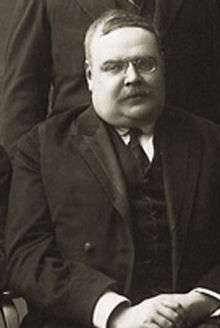Krajowcy

The Krajowcy (Polish pronunciation: [kraˈjɔft͡sɨ], Fellow Countrymen or Natives;[1] Lithuanian: krajovcai, Belarusian: Краёўцы) was a group of mainly Polish-speaking intellectuals from the Vilnius Region who, at the beginning of the 20th century, opposed the division of the former Polish–Lithuanian Commonwealth into nation states along ethnic and linguistic lines.[2] The movement was a reaction against growing nationalism in Poland, Lithuania and Belarus. The Krajowcy attempted to maintain their dual self-identification as Polish–Lithuanian (gente Lithuanus, natione Polonus) rather than just Polish or Lithuanian. The Krajowcy were scattered and few in number and as a result failed to organize a widescale social movement.[2]
Views
The Krajowcy were mostly descendants of the nobles of the former Grand Duchy of Lithuania (Lithuanian nobility being part of the szlachta).[1] They identified themselves with Polish culture, but maintained a sense of loyalty to the old Grand Duchy. The Krajowcy consisted of two wings: the conservative-moderate wing, composed mostly of large landowners, and the democratic wing, formed from the Vilnius intelligentsia.[3] The conservative wing was generally wary of social upheaval and thus supported authorities of the Russian Empire. They sought expansion of local self-government and cultural freedoms, but did not wish to separate Lithuania from the Russian Empire.[3] The democratic Krajowcy wanted to neutralize ethnic strife and proposed the creation of a civil society in the former territory of the Grand Duchy (principally Lithuania and Belarus), which would include Lithuanians, Poles, Belarusians, Jews, Ukrainians, and other nationalities.[1] To them, national identity was not important as long as the person identified with and felt loyalty to the former Duchy. In their view, the Lithuanian state would be formed based not on ethnicity, but on citizenship. The democratic Krajowcy relied on and encouraged the Belarusian and Lithuanian National Revivals, but only to an extent—they opposed nation states and anti-Polonization.[3] They did not want to cut the cultural ties with Poland as they saw it as an integral part of Lithuanian and Belarusian history and heritage. The democratic krajowcy either lukewarmly supported or opposed the Polish federalists who dreamed of resurrecting the Polish-led Commonwealth.[3] These ideas were not adopted by the nationalists: the Lithuanians resented Polish culture and the Poles could not adopt regional traditions and loyalties.[4]
Members
Bishop Antanas Baranauskas (1835–1902) held views similar to the early Krajowcy (although he was not one of them). Even though he wrote about "our dear nation" in the Lithuanian language, he was against disintegration of the former Grand Duchy into ethnic entities: he was against both Lithuanian and Polish nationalism, and hoped that the Lithuanian and Polish languages and cultures could co-exist and expand together.[2]
The democratic Krajowcys were led by Michał Römer / Mykolas Römeris (1880–1946), Tadeusz Wróblewski (1858–1925)[5] and Ludwik Abramowicz (1879–1939).[6] After the outbreak of World War I, and especially after the re-establishment of the Polish and Lithuanian national states, members of the Krajowcy were hard pressed to hold onto their dual self-identification and had to declare their loyalty to one country or the other. Most of them, like Mieczysław Jałowiecki, declared loyalty to Poland.[7] Some, like Michał Pius Römer and Stanisław Narutowicz, chose Lithuania and became citizens there. Raman Skirmunt, an activist of the Krajowcy movement in Belarus, became one of the leaders of the Belarusian Democratic Republic.
References
- 1 2 3 Staliūnas, Darius (July 2005). "From Ethnocentric to Civic History: Changes in Contemporary Lithuanian Historical Studies" (PDF). In Kimitaka Matsuzato. Emerging Meso-Areas in the Former Socialist Countries: Histories Revived or Improvised?. Slavic Eurasian studies. 7. Slavic Research Center, Hokkaido University. p. 325. ISBN 978-4-938637-35-4.
- 1 2 3 Krapauskas, Virgil (2000). Nationalism and Historiography: The Case of Nineteenth-Century Lithuanian Historicism. New York: Columbia University Press. pp. 38, 95–96, 159. ISBN 0-88033-457-6.
- 1 2 3 4 Kulakauskas, Antanas (2002). "Lietuvių ir lenkų santykiai XX a. pradžioje". Gimtoji istorija: Nuo 7 iki 12 klasės (in Lithuanian). Vilnius: Elektroninės leidybos namai. ISBN 9986-9216-9-4.
- ↑ Snyder, Timothy (2004). The reconstruction of nations: Poland, Ukraine, Lithuania, Belarus, 1569–1999. Yale University Press. p. 55. ISBN 978-0-300-10586-5.
- ↑ Kulikauskienė, Jadvyga (2001–2002). "1940-2000 m. publikacijų apie Tado Vrublevskio gyvenimą ir veiklą apžvalga" (PDF). Lietuvos mokslų akademijos biblioteka (in Lithuanian): 43. ISSN 1648-9772.
- ↑ Wandycz, Piotr Stefan (1974). The lands of partitioned Poland, 1795-1918. A History of East Central Europe. 7. University of Washington Press. p. 349. ISBN 978-0-295-95358-8.
- ↑ Neubauer, John; Włodzimierz Bolecki (2010). "Two Regionalists of the Interwar Period: Józef Mackiewicz and Mária Berde". In Marcel Cornis-Pope, John Neubauer. History of the Literary Cultures of East-Central Europe: Junctures and disjunctures in the 19th and 20th centuries. Comparative History of Literatures in European Languages. 4. John Benjamins Publishing Company. p. 541. ISBN 978-90-272-3458-2.